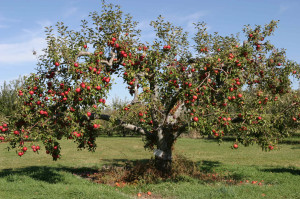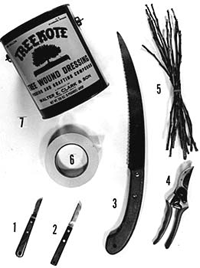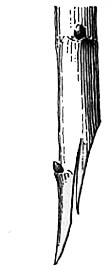Picture Courtesy of: http://www.treemendus-fruit.com/apples.htm
BACKGROUND: One of the most commonly grafted deciduous trees is the apple tree. It allows for a small portion of a desired to tree to be placed on an existing growing structure that has root formation and nutrients available for the newly grafted piece to be successful. There are many ways to do this process. One of those processes is called budding. With budding, you take the bud of an apple tree off of a scion. You then create a t-cut in the root-stock that you wish to propagate the scion onto. You then wrap it and care for it like a normal plant. You will then see progress within 6 weeks if the budding process was successful. This is very common in large scale production apple farms. For a visual on how to bud an apple tree, watch this YouTube video: https://www.youtube.com/watch?v=LTqG8-OhElY . For this page, we will be covering a different type of grafting used, called Whip-and-Tongue grafting technique. The reason for the Whip-and-Tongue grafting technique is because it is more sturdier than just a splice graft, which is the same thing as whip-and-tongue, without the tongue component.
Picture Courtesy of: http://www.hort.cornell.edu/grafting/methods.alpha/WTMeth.html
TOOLS:
- Budding knife
- Grafting knife
- Pruning shears
- Dormant scions (cultivar labeled)
- Tying material such as grafting tape, adhesive tape, electrician’s ber tape or rubber strips
- Asphalt water emulsion compound for covering grafts (Hertz, 2015)
Picture courtesy of: http://www.extension.umn.edu/garden/yard-garden/fruit/grafting-and-budding-fruit-trees/
PROTECTIVE COATING: All grafts should be immediately covered with a water emulsion material. For this purpose, I have chosen to use para-film. Other options commonly used are electricians tape. With this tape, you do not want to stretch it too much for risk of cracking and breaking. Another way is with asphalt water emulsion, which is used on more commercial properties (Hertz, 2015).
Procedure:
1. Select a scion that is very close in diameter to the root-stock that you have chosen. Make sure the scion has three to four buds present (3-4).
2. Make a sloping cut 1-2 inches at the base of the bud.
Picture Courtesy of: http://www.hort.cornell.edu/grafting/methods.alpha/WTMeth.html
3. On the root-stock, select a smooth area that you will make an identical cut to the 1-2 inch scion piece you made in the previous step. Make the same sloping cut on your root-stock at 1-2 inches.
4. On the sloping cut part of the scion, go about a third of the distance down the length of the cut, starting from the top-pointed piece. At this distance, you will want to make a parallel cut to the scion, at about a half inch deep.
5. Follow the previous instructions for the root-stock. You have then just created the “tongue” portion of the whip-and-tongue graft.
6. Place the scion onto the root-stock. Interlock the tongues so that the scion and root-stock are connected. It is very important to have the cambium layers match up from both pieces. If the scion is smaller than the root-stock in diameter, be sure to have at least one side of the scion and root-stock line up to ensure contact in the cambium layer. If the scion and root-stock have the same diameter, the cambium layer will be lined up on both sides.
7. The graft must now be supported. Use grafting rubber to hold the graft firmly into place. Tie it off. The take your para-film or other material, and firmly wrap the graft to help hold moisture in.
Previous steps taken from: Horticulture 202 Budding and Grafting Lab, 2015
CAMBIAL CONTACT IMPORTANCE:”Cambium, plural Cambiums, or Cambia, in plants, layer of actively dividing cells between xylem (wood) and phloem (bast) tissues that is responsible for the secondary growth of stems and roots (secondary growth occurs after the first season and results in increase in thickness). Theoretically, the cambium is a single layer of cells, called initial cells; practically, it is difficult to distinguish the initials from their still-undifferentiated daughter cells, and several cell layers are collectively called the cambium, or cambial zone. Cambial cells divide to produce secondary xylem cells toward the central axis of the stem and secondary phloem cells toward the outside. The cambium originates from undifferentiated cells that have retained their embryonic capacity for continued growth and differentiation. A cambium may also form within callus tissues—masses of cells that grow over the injured surface of a wound, leading to healing.” (Cambium, 2014)
AFTERCARE: Using potting soil, place the grafter woods into a pot with potting soil and water. Using potting soil will ensure that the graft has all the nutrients it needs to be successful, whereas field soil may contain diseases and pest and will not help in a successful graft. Check on the graft daily. If there are any buds or growth below the graft point (on the root stock), remove. The nutrients will go to this growth instead of the cambial contact area. Removing the growths will make the nutrients go to where it is needed most. After two weeks, you should see growth from the scion, but that does not mean the graft was successful. Continue to water and monitor growth on the grafted union. Sunlight is beneficial to all living organisms, but too much can be harmful. If the soil dries out too quickly, move grafting to a shaded place and continue watering regularly (Trees of Joy, 2011).
RESOURCES:
Hertz, L. (2015, January 1). Grafting and budding fruit trees. Retrieved March 30, 2015, from http://www.extension.umn.edu/garden/yard-garden/fruit/grafting-and-budding-fruit-trees/
Reddivari, L. (Director) (2015, March 26). Horticulture 202 . Budding and grafting Lab. Lecture conducted from Pennsylvania State University, University Park.
Cambium | plant anatomy. (2014, October 23). Retrieved March 30, 2015, from http://www.britannica.com/EBchecked/topic/90505/cambium
Whip and tongue Grafting. (2011, July 19). Retrieved March 30, 2015, from http://www.treesofjoy.com/content/whip-and-tongue-grafting
Whip and Tongue Grafting. (2015, January 1). Retrieved March 30, 2015, from http://www.hort.cornell.edu/grafting/methods.alpha/WTMeth.html



